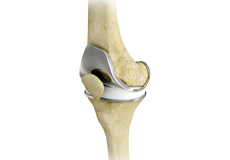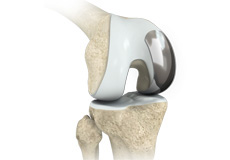Joint Replacement Surgery
Hip joint and knee joint replacements are helping people of all ages live pain- free, active lives.
Joints are formed by the ends of two or more bones connected by tissue called cartilage. Healthy cartilage serves as a protective cushion, allowing smooth, low-friction movement of the joint. If the cartilage becomes damaged by disease or injury, the tissues around the joint become inflamed, causing pain. With time, the cartilage wears away, allowing the rough edges of bone to rub against each other, causing more pain.
When only some of the joint is damaged, a surgeon may be able to repair or replace just the damaged parts. When the entire joint is damaged, a total joint replacement is done. To replace a total hip or knee joint, a surgeon removes the diseased or damaged parts and inserts artificial parts, called prostheses or implants.
Click the desired topics below to find out more.
Minimally Invasive Joint Replacement

Same Day Total Knee Replacement TKR and Same Day Total Shoulder Replacement TSR are very successful surgical treatment for arthritis of the knee and shoulder respectively.
Computer Assisted Hip and Knee Joint Replacement

Computer Assisted Surgery (CAS) technology allows the surgeon to simultaneously visualize two- or three-dimensional views of the patient’s anatomy on a monitor, and provides real-time, intra-operative views of surgical instruments and the relative digital positioning of implantable devices.
Total Knee Replacement (TKR)

A Total Knee Replacement (TKR) or Total Knee Arthroplasty is a surgery that replaces an arthritic knee joint with artificial metal or plastic replacement parts called the ‘prostheses’.
Unicondylar (Unicompartmental) Knee Replacement

Unicondylar Knee Replacement simply means that only a part of the knee joint is replaced through a smaller incision than would normally be used for a total knee replacement.





